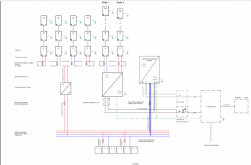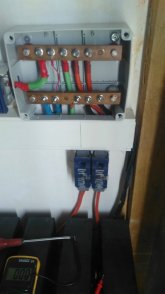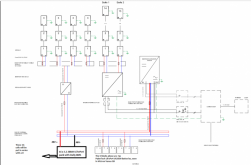Hello everyone,
I've been helping my parents with their off grid system in Spain.
If you want full background, check out these 2 links, the first one is quite Victron specific, the second link is basically the same as what I'm about to ask.
First thread:
 community.victronenergy.com
community.victronenergy.com
Second thread:
 community.victronenergy.com
community.victronenergy.com
So, my question:
My parents have 6 US2000 Pylontech LiFePO4 batteries, 15 cell each (which is rather odd). All are connected in parallel, this is the schematic :

I want to add a DIY LiFePO4.
Thanks to the Victron feedback (check second link above), I learned that the US2000's are 15 cell instead of the "normal" 16 cell.
Therefore: I want to buy either 15cells or 30 (15s or 15s2p) LiFePO4 200AH.
So basically I would go for:
15 (or 30) of these cells: link (common sense would advise 30 cells, but the bank account might advice differently)
And a Daly BMS (because YouTube is full of great Daly reviews, must be good), this for example. I'm not sure if I'd need 2 BMS's or 1 if I go for 30 cells (15s2p), but I'll figure that out later.
Anyway, my schematic would look like this:

Note: I would use 15 cells, not 16 as mentioned on the schematic
I would just parallel them to the existing batteries since there are vacant connection holes on the bars:

The real question is:
Let me know, thanks.
Regards,
Hendrik
I've been helping my parents with their off grid system in Spain.
If you want full background, check out these 2 links, the first one is quite Victron specific, the second link is basically the same as what I'm about to ask.
First thread:
Why is this system not fully charging the batteries from AC PV? - Victron Community
Second thread:
Add a second LiFePO4 battery bank - is my schematic ok? - Victron Community
So, my question:
My parents have 6 US2000 Pylontech LiFePO4 batteries, 15 cell each (which is rather odd). All are connected in parallel, this is the schematic :

I want to add a DIY LiFePO4.
Thanks to the Victron feedback (check second link above), I learned that the US2000's are 15 cell instead of the "normal" 16 cell.
Therefore: I want to buy either 15cells or 30 (15s or 15s2p) LiFePO4 200AH.
So basically I would go for:
15 (or 30) of these cells: link (common sense would advise 30 cells, but the bank account might advice differently)
And a Daly BMS (because YouTube is full of great Daly reviews, must be good), this for example. I'm not sure if I'd need 2 BMS's or 1 if I go for 30 cells (15s2p), but I'll figure that out later.
Anyway, my schematic would look like this:

Note: I would use 15 cells, not 16 as mentioned on the schematic
I would just parallel them to the existing batteries since there are vacant connection holes on the bars:

The real question is:
- Would this work? Just paralleling the new battery onto the 2 bars (plus and minus). I would definitely say yes.
- Would it harm the Pylontech batteries? I think not, because all 6 pylontech batteries are protected by their own BMS. And Victron limits the current to 140A anyway (setting in Victron which I could modify if need be).
- Would it harm the DIY pack? I think not, since it's capacity is bigger, and each cell is rated arount 200A continuous discharge current, 140A should be fine (as configured in victron). Also Daly would protect it if I take say a 150A BMS.
- I hear talk about it not being healthy to combine smaller & bigger battery packs, but I disagree: Two interconnected watertanks (same height) will fill evenly no matter there volume. Therefore, following the water analogy, both batteries will be full at the same time (provided that each cell in both packs equals 3.2V, resistance is the same, etc.).
- Can i mess anything up? I really thought it over, watched "all" off Will's videos (and others), and think all will be fine.
Let me know, thanks.
Regards,
Hendrik
Last edited:



